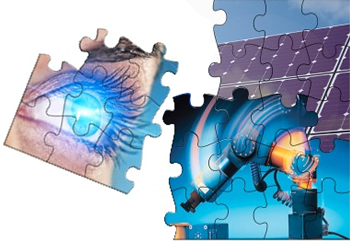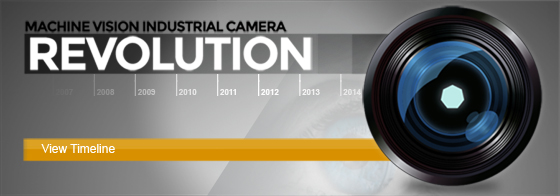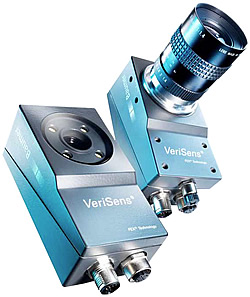 The pace of technological development is quickening. Over the past decade, next-generation network connections and cloud-based computing have gifted manufacturers with a bevy of powerful new tools and revolutionized the means by which data is collected, analyzed and shared. New technologies have also given rise to a new generation of flexible, precise and intuitive machine vision systems with the potential to reorder the production process.
The pace of technological development is quickening. Over the past decade, next-generation network connections and cloud-based computing have gifted manufacturers with a bevy of powerful new tools and revolutionized the means by which data is collected, analyzed and shared. New technologies have also given rise to a new generation of flexible, precise and intuitive machine vision systems with the potential to reorder the production process.
Machine Vision through the Years
Machine vision technology has existed for more than three decades. Early devices were bulky, cart-sized assemblies that were difficult to manage and could perform only the most basic acquisition and extraction tasks. Machine vision camera technology has improved markedly since then, but the software, interfaces and data transmission protocols that surround modern machine vision systems have struggled to keep pace with technological development in other sectors. Until recently, most machine vision users have deployed serviceable, but inflexible and often unintuitive software programs to control their devices.
Systems and Processes for a Digital World
This is finally changing for the better. The next generation of machine vision systems leverages several momentous technological trends to exceed expectations in a variety of applications.
First, the unlimited data storage and computing power of the cloud create an environment in which machine vision systems are no longer constrained by their native storage capacities or their software progra ms' processing limitations. Just as importantly, open APIs and cutting-edge visual algorithms dramatically enhance these systems' flexibility and reduce or eliminate the inherent inefficiency of manual reprogramming. Visual-capture technology has also improved by leaps and bounds: If modern smartphones now boast superior capture speeds and pixel counts relative to the digital cameras of the last decade, imagine the parallel improvements to industrial machine vision technology.
ms' processing limitations. Just as importantly, open APIs and cutting-edge visual algorithms dramatically enhance these systems' flexibility and reduce or eliminate the inherent inefficiency of manual reprogramming. Visual-capture technology has also improved by leaps and bounds: If modern smartphones now boast superior capture speeds and pixel counts relative to the digital cameras of the last decade, imagine the parallel improvements to industrial machine vision technology.
Toward Integrated, Flexible Machine Vision Systems
For producers who have had mixed success with machine vision technology in the past, the new crop of systems has the potential to break down many longstanding barriers. Since they necessitate the intervention of slower, more expensive human workers, "old-line" machine vision QA applications that fail to identify potential product defects or generate false positive readings can sap productivity. If automated and manual checks both fail to catch problems, the resultant product recalls are liable to affect profitability in an even bigger way.
Modern machine vision systems boast efficiencies of up to 100 checks per second and no longer function as isolated units that require hands-on reprogramming and repair. They still require human oversight, of course, but their newfound power enables supervisors to perform complementary roles that don't demand constant interaction. In fact, the shift to responsive, flexible, and precise systems repositions human workers as analysts and curators of the massive data streams that these machines produce. The era of babysitting machine vision QA systems on the production line is over.
The Gift of Data: Smarter Production, Smarter Workers
The newfound computing power and data transmission capabilities of these modern systems provide users with a valuable, self-replicating asset: data. Whereas standalone machine vision systems with limited internal storage must periodically overwrite collected data to make room for new inputs, cloud storage allows producers and QA specialists to collect, aggregate and retrieve pertinent data in perpetuity.
Over time, this information can be used to identify patterns, establish causation, and implement new protocols to further streamline and strengthen the production process. Decision makers can allocate analytic and interpretive tasks to talented engineers and data experts who might otherwise be supervising or maintaining less reliable systems. The result: a more efficient, more productive production line that delivers on its commitment to quality.
An Intuitive Machine Vision Solution for an Empowered Production Line
 The power of modern machine vision technology, placed in the right hands, should be clear. How can manufacturers leverage exciting developments in this space for their own QA operations? Start with the Baumer VeriSens, a powerful device that performs up to 100 checks per second and relays the resultant data via digital I/Os and its internal process interface. The system comes with a free choice of lenses and an integrated flash controller. It can also be paired with a variety of lighting options, adapter cables and other accessories. Expect nothing less from the future of industrial machine vision technology.
The power of modern machine vision technology, placed in the right hands, should be clear. How can manufacturers leverage exciting developments in this space for their own QA operations? Start with the Baumer VeriSens, a powerful device that performs up to 100 checks per second and relays the resultant data via digital I/Os and its internal process interface. The system comes with a free choice of lenses and an integrated flash controller. It can also be paired with a variety of lighting options, adapter cables and other accessories. Expect nothing less from the future of industrial machine vision technology.

